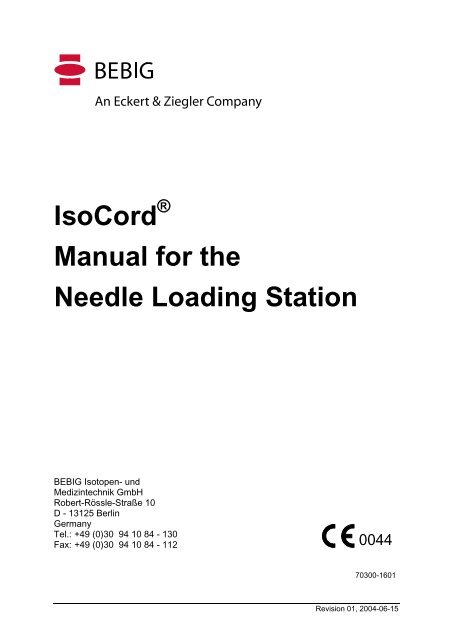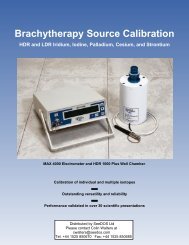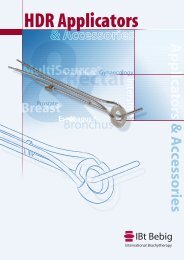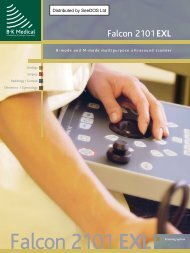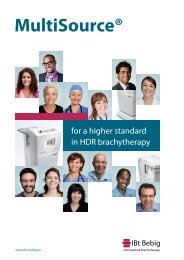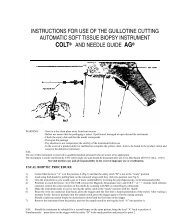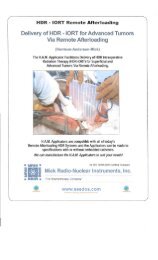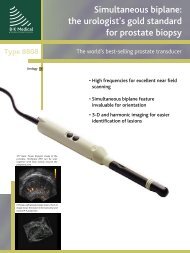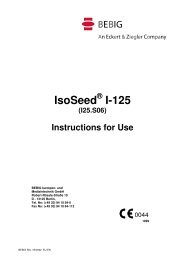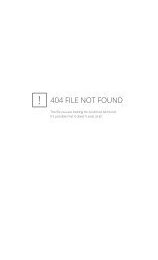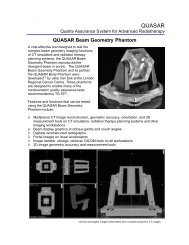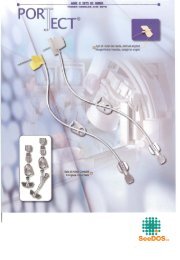IsoCord Needle Loading Station - SeeDos, UK
IsoCord Needle Loading Station - SeeDos, UK
IsoCord Needle Loading Station - SeeDos, UK
You also want an ePaper? Increase the reach of your titles
YUMPU automatically turns print PDFs into web optimized ePapers that Google loves.
<strong>IsoCord</strong> ®<br />
Manual for the<br />
<strong>Needle</strong> <strong>Loading</strong> <strong>Station</strong><br />
BEBIG Isotopen- und<br />
Medizintechnik GmbH<br />
Robert-Rössle-Straße 10<br />
D - 13125 Berlin<br />
Germany<br />
Tel.: +49 (0)30 94 10 84 - 130<br />
Fax: +49 (0)30 94 10 84 - 112<br />
0044<br />
70300-1601<br />
Revision 01, 2004-06-15
<strong>IsoCord</strong><br />
Manual for the<br />
<strong>Needle</strong> <strong>Loading</strong> <strong>Station</strong><br />
Content<br />
1. Manufacturer ....................................................................................................... 3<br />
2. Introduction and Intended Use ............................................................................ 3<br />
3. Product Description ............................................................................................. 5<br />
4. Accessories ......................................................................................................... 6<br />
5. Use...................................................................................................................... 8<br />
5.1. Preparation................................................................................................... 8<br />
5.2. Insert the Magazine...................................................................................... 9<br />
5.3. Insertion of the Drive Knob and Checking of the Seed Chain .................... 10<br />
5.4. Mounting the <strong>Needle</strong> .................................................................................. 10<br />
5.5. Moving the Magazine Holder into the “<strong>IsoCord</strong> position”............................ 11<br />
5.6. Dispensing ................................................................................................. 11<br />
5.7. Cutting of the Seed Chain .......................................................................... 12<br />
5.8. Moving the Magazine into the “mandrel position”...................................... 13<br />
5.9. <strong>Loading</strong> the Trimmed Seed Chain Piece into the <strong>Needle</strong>........................... 14<br />
5.10. Removing the <strong>Needle</strong>................................................................................. 15<br />
5.11. <strong>Loading</strong> more <strong>Needle</strong>s ............................................................................... 15<br />
5.12. End of the Seed Chain ............................................................................... 15<br />
5.13. End of <strong>Loading</strong> ........................................................................................... 15<br />
5.14. Removing Magazine................................................................................... 16<br />
6. Directions for the Implantation............................................................................17<br />
6.1. Sealing the Implant <strong>Needle</strong>s ...................................................................... 17<br />
6.2. Seed Type.................................................................................................. 17<br />
6.3. Correction of the Implantation Depth.......................................................... 17<br />
7. Maintenance and Sterilization ............................................................................18<br />
8. Safety Instructions..............................................................................................22<br />
9 Trouble Shooting ....................................................................................................23<br />
9.1 The Seed Chain Does not Move out of the Magazine..................................... 23<br />
9.2 The Seed Chain Does not Thread into the Positioning System ...................... 25<br />
9.3 The Seed Chain Piece Gets Stuck in the Guiding System ......................... 26<br />
9.4 The Strand will not Completely load into the <strong>Needle</strong>.................................. 26<br />
9.5 Damage of a Seed ..................................................................................... 27<br />
<strong>IsoCord</strong> <strong>Needle</strong> <strong>Loading</strong> <strong>Station</strong> Manual 2 Rev. 01 / 2004-06-15
<strong>IsoCord</strong><br />
Manual for the<br />
<strong>Needle</strong> <strong>Loading</strong> <strong>Station</strong><br />
1. Manufacturer<br />
BEBIG Isotopen- und Medizintechnik GmbH<br />
Robert-Rössle-Str. 10, D-13125 Berlin<br />
Tel.: +49 (30) 94 10 84-130<br />
Fax: +49 (30) 94 10 84-112<br />
e-mail: info@bebig.de<br />
www.bebig.de<br />
2. Introduction and Intended Use<br />
Interstitial Brachytherapy is a treatment method for prostate cancer with little side<br />
effects which is becoming more and more popular. Small completely encapsulated<br />
radioactive implants, so-called seeds, are introduced into the prostate and remain<br />
there. The radiation emitted by the seeds destroys the tumor cells.<br />
The seed implantation can be done in different ways. The device described here is<br />
used for the so-called “pre-loaded needle“ technique. According to a treatment plan,<br />
implantation needles are loaded with a certain number of seeds and spacers. Each<br />
needle is inserted at a certain position, and the loaded number of seeds and spacers<br />
is implanted into the prostate at a certain track and depth.<br />
The loading can be done with loose seeds and spacers. The user sorts seeds and<br />
spacers alternately and slides them into the desired needle. Alternatively one can<br />
work with a ready-made seed chain, a so-called strand. Therefore, the seed chain<br />
has to be cut to the appropriate length, for example into a piece containing four<br />
seeds. This four seeds piece is then inserted into the needle.<br />
The <strong>IsoCord</strong> seed chain contains seeds and spacers in an alternating sequence, with<br />
10 mm distance between the middle of two consecutive seeds. The <strong>IsoCord</strong> seed<br />
chain is housed in a magazine due to radiation safety and ease of use requirements.<br />
A magazine can contain up to 75 seeds.<br />
Intended Use<br />
The <strong>IsoCord</strong> <strong>Needle</strong> <strong>Loading</strong> <strong>Station</strong> is used to move the <strong>IsoCord</strong> seed chain out of<br />
its magazine, cut the chain into the defined lengths and move these cut lengths or<br />
strands into the attached implantation needle. While performing the steps above, the<br />
user is very well shielded from the emitted radiation of the seeds.<br />
<strong>IsoCord</strong> <strong>Needle</strong> <strong>Loading</strong> <strong>Station</strong> Manual 3 Rev. 01 / 2004-06-15
<strong>IsoCord</strong><br />
Manual for the<br />
<strong>Needle</strong> <strong>Loading</strong> <strong>Station</strong><br />
User<br />
The use of the <strong>IsoCord</strong> system is restricted to personnel specially trained in radiation<br />
safety and the proper use of the provided equipment.<br />
Bebig provides a certain training to dedicated users when the system is installed in<br />
the clinic. The successful training is documented by a certificate from Bebig. Only<br />
personnel holding this certificate is allowed to work with the <strong>IsoCord</strong> system.<br />
Further Information<br />
In the following, the use of the <strong>IsoCord</strong> <strong>Needle</strong> <strong>Loading</strong> <strong>Station</strong> with <strong>IsoCord</strong> seed<br />
chains is described.<br />
For further information about the <strong>IsoCord</strong> seed chain itself, especially about the<br />
physics of the seeds, please refer to the corresponding manual.<br />
In the following, the term seed chain is used to describe the whole length of the seed<br />
chain which is still in or connected to its magazine, while the term strand is used to<br />
describe a cut piece of the seed chain, which will be put into an implantation needle.<br />
<strong>IsoCord</strong> <strong>Needle</strong> <strong>Loading</strong> <strong>Station</strong> Manual 4 Rev. 01 / 2004-06-15
<strong>IsoCord</strong><br />
Manual for the<br />
<strong>Needle</strong> <strong>Loading</strong> <strong>Station</strong><br />
3. Product Description<br />
<strong>IsoCord</strong> <strong>Needle</strong> <strong>Loading</strong> <strong>Station</strong><br />
The <strong>IsoCord</strong> <strong>Needle</strong> <strong>Loading</strong> <strong>Station</strong>, BEBIG article NLS.101, is composed of six<br />
main components which are mounted to a common base plate.<br />
1: <strong>Needle</strong> Holder<br />
Here the implantation needle will be attached.<br />
2: Movable Magazine Holder<br />
When the <strong>IsoCord</strong> magazine is inserted into the magazine holder, the<br />
transportation lock is automatically disabled. The holder can be moved between<br />
two positions. In the so-called “<strong>IsoCord</strong> position”, the outlet of the magazine is<br />
aligned with the adjacent guiding system so that the seed chain can be moved<br />
out. In the other position, the so-called “mandrel position”, the built-in mandrel is<br />
aligned in such a way that the cut strand can be moved with the mandrel into the<br />
attached needle.<br />
<strong>IsoCord</strong> <strong>Needle</strong> <strong>Loading</strong> <strong>Station</strong> Manual 5 Rev. 01 / 2004-06-15
<strong>IsoCord</strong><br />
Manual for the<br />
<strong>Needle</strong> <strong>Loading</strong> <strong>Station</strong><br />
3: Drive Knob<br />
The knob is inserted into the magazine. By turning the knob counterclockwise the<br />
contents of the magazine are propelled forward and the seed chain moves out of<br />
the magazine.<br />
4: Positioning Unit with Lighting<br />
The front of this unit is covered with a sheet of stainless steel which provides<br />
optimal radiation protection for the user. The seed chain is illuminated to allow a<br />
safe distinction between seeds and spacers while it is watched in the mirror. The<br />
power for the light is provided by an external power supply unit.<br />
5: Cutting System<br />
The cutting system facilitates an exact cut of the correctly positioned seed chain<br />
in the middle of a spacer.<br />
6: Built-in Mandrel<br />
It is used to move the cut strand into the attached needle. A return spring pulls the<br />
mandrel back into its starting position.<br />
4. Accessories<br />
To load implantation needles with seed chain pieces, the user needs the needles and<br />
the seed chain itself. More accessories for handling failures are provided.<br />
<strong>IsoCord</strong> Chain in Magazine<br />
The <strong>IsoCord</strong> <strong>Needle</strong> <strong>Loading</strong> <strong>Station</strong> can and may only be used with an <strong>IsoCord</strong><br />
seed chain in its magazine.<br />
Implantation <strong>Needle</strong>s<br />
In principle, any 18 Gauge (ETW, BETW or UTW) prostate implantation needles can<br />
be used with the <strong>IsoCord</strong> <strong>Needle</strong> <strong>Loading</strong> <strong>Station</strong>. The only requirements for their<br />
use with the <strong>IsoCord</strong> system are that they have a minimum inner diameter of 1.04<br />
mm and that their connection fits the needle holder.<br />
This is certainly the case for the needles provided by BEBIG; therefore, we<br />
recommend to use only these needles, BEBIG article number 000.430.<br />
<strong>IsoCord</strong> Sterilisation Tray (NLZ.100)<br />
This tray has defined positions for the <strong>Needle</strong> <strong>Loading</strong> <strong>Station</strong> and its accessories<br />
find a dedicated place in the in sterilisation tray. This tray can also be used for storing<br />
the parts.<br />
<strong>IsoCord</strong> <strong>Needle</strong> <strong>Loading</strong> <strong>Station</strong> Manual 6 Rev. 01 / 2004-06-15
<strong>IsoCord</strong><br />
Manual for the<br />
<strong>Needle</strong> <strong>Loading</strong> <strong>Station</strong><br />
<strong>IsoCord</strong> Screw Driver (NLZ.101)<br />
If the drive knob is turned too far into the “Magazine” direction, the seed chain might<br />
disappear completely into the magazine or even slip out of the drive mechanism. In<br />
this case the magazine inspection flap has to be opened to re-thread the seed chain.<br />
A sterilizable hexagonal screw driver is provided for this purpose.<br />
<strong>IsoCord</strong> Waste Container (NLZ.102)<br />
The stainless steel waste container is used to store remaining pieces of the seed<br />
chain. Since it is sterilizable, it can be used on the sterile workplace. Its wall<br />
thickness is sufficient shield the radiation from the iodine seeds.<br />
<strong>IsoCord</strong> Tweezers (NLZ.103)<br />
The tweezers have a rounded tip but slightly rough jaws to hold the seed chain<br />
without damaging it. They can be sterilized, but may not be used for surgical<br />
procedures.<br />
<strong>IsoCord</strong> Scissors (NLZ.104)<br />
The scissors are used to cut the seed chain precisely at a spacer position when<br />
required e.g. to divide a strand that has already been cut. They are sterilizable.<br />
<strong>IsoCord</strong> Power Supply<br />
The light inside the <strong>Needle</strong> <strong>Loading</strong> <strong>Station</strong> is powered by an external power supply<br />
unit. This unit (NLZ.105) and the corresponding power cord (NLZ.106) are available<br />
as replacement parts. They cannot be sterilized.<br />
<strong>IsoCord</strong> <strong>Needle</strong> Rack (NLZ.107)<br />
Optionally, a shielded needle rack is available to hold the preloaded needles until<br />
they are implanted. The needle rack can be sterilized.<br />
<strong>IsoCord</strong> <strong>Needle</strong> <strong>Loading</strong> <strong>Station</strong> Manual 7 Rev. 01 / 2004-06-15
<strong>IsoCord</strong><br />
Manual for the<br />
<strong>Needle</strong> <strong>Loading</strong> <strong>Station</strong><br />
5. Use<br />
The following describes the preparation and the use of the <strong>IsoCord</strong> <strong>Needle</strong> <strong>Loading</strong><br />
<strong>Station</strong>.<br />
5.1. Preparation<br />
The <strong>Needle</strong> <strong>Loading</strong> <strong>Station</strong> and its accessories must be sterilized prior to their use<br />
according to the instructions given in chapter 7, Maintenance and Sterilization. Also,<br />
a sufficient number of needles has to be available.<br />
The sterile workplace is set up according to the local procedures. A sterile area, 70<br />
cm wide and 50 cm deep, is sufficient. There should be a power outlet close to the<br />
sterile area and a safe place for the power supply of the positioning unit.<br />
Place the <strong>Needle</strong> <strong>Loading</strong> <strong>Station</strong> in the lower right part of the workplace facing the<br />
user. This ensures that the attached needle is completely inside the sterile area. The<br />
space behind the <strong>Needle</strong> <strong>Loading</strong> <strong>Station</strong> can be used as sterile storage area for the<br />
prepared needles, the magazine(s) and the needle rack. The sterilized accessories<br />
including scissors, tweezers, waste container and the hexagonal screw driver, can be<br />
positioned below the <strong>Needle</strong> <strong>Loading</strong> <strong>Station</strong>.<br />
Before you start, check that you have all of the equipment required.<br />
<strong>IsoCord</strong> <strong>Needle</strong> <strong>Loading</strong> <strong>Station</strong> Manual 8 Rev. 01 / 2004-06-15
<strong>IsoCord</strong><br />
Manual for the<br />
<strong>Needle</strong> <strong>Loading</strong> <strong>Station</strong><br />
Connect the sterile cable of the <strong>Needle</strong><br />
<strong>Loading</strong> <strong>Station</strong> with the nonsterile one of the<br />
power supply unit, but do it outside the sterile<br />
area. Pay attention to the orientation of the<br />
connectors: the tongue of one connector has<br />
to fit to the groove of the other. Now you can<br />
connect the power supply unit to an electrical<br />
outlet.<br />
Change the sterile gloves afterwards or let someone else handle the unsterile part.<br />
There might be residue from the steam sterilization on the mirror surface of the<br />
<strong>Needle</strong> <strong>Loading</strong> <strong>Station</strong> which can disturb the view of the seeds. This residue should<br />
be wiped using a sterile swap.<br />
Prepare the needles. Seal the needle tips using common techniques. Take a<br />
magazine out of its sterile packaging.<br />
5.2. Insert the Magazine<br />
After preparing the workplace and equipment as described<br />
above, the needles can be loaded. Take a magazine and<br />
unscrew the radiation protection cap.<br />
Insert the magazine into the corresponding<br />
holder of the <strong>Needle</strong> <strong>Loading</strong><br />
<strong>Station</strong>. Put the left side down first so<br />
that the connector piece fits into the<br />
bush of the holder.<br />
Then press down the right side. If necessary,<br />
jiggle it a little bit up and down<br />
until it fits in. The transportation lock of<br />
the magazine is automatically released<br />
by the little pin located in the right lower<br />
corner of the holder. It might seem a little<br />
tight, but with some practice it is easy to<br />
do. An accurate fit is necessary for precise<br />
cutting of the seed chain.<br />
<strong>IsoCord</strong> <strong>Needle</strong> <strong>Loading</strong> <strong>Station</strong> Manual 9 Rev. 01 / 2004-06-15
<strong>IsoCord</strong><br />
Manual for the<br />
<strong>Needle</strong> <strong>Loading</strong> <strong>Station</strong><br />
5.3. Insertion of the Drive Knob and Checking of the Seed Chain<br />
Insert the drive knob into the magazine.<br />
Make sure that the orientations of the two<br />
hexagons coincide.<br />
Check if the seed chain can be moved<br />
out now. The magazine holder has to be<br />
in the so-called “mandrel position” (see<br />
paragraph 5 and 8 in this chapter). In this<br />
position the bushing of the holder, where<br />
the seed chain moves out, is visible.<br />
Turn the knob counterclockwise by a few<br />
degrees (identified by the notches at the<br />
periphery of the drive knob), i.e., in the<br />
direction indicated by the inscription<br />
“<strong>Needle</strong>” on the knob. The knob should<br />
be easily turned, without much<br />
resistance, and the seed chain should<br />
come out of the bushing. If this is not the<br />
case, do not try to turn the knob forcibly,<br />
but proceed as recommended in chapter<br />
9, Trouble Shooting.<br />
Now turn the drive knob clockwise, i.e., into the direction<br />
indicated by the inscription “Magazine” on the knob, until<br />
the tip of the seed chain is flush with the bushing.<br />
5.4. Mounting the <strong>Needle</strong><br />
Move the hub of the needle over the<br />
tip of the needle holder until the jaws<br />
clamp the needle as shown in the<br />
picture. It is just a little push and<br />
click. If necessary, turn the needle<br />
slightly.<br />
<strong>IsoCord</strong> <strong>Needle</strong> <strong>Loading</strong> <strong>Station</strong> Manual 10 Rev. 01 / 2004-06-15
<strong>IsoCord</strong><br />
Manual for the<br />
<strong>Needle</strong> <strong>Loading</strong> <strong>Station</strong><br />
5.5. Moving the Magazine Holder into the “<strong>IsoCord</strong> position”<br />
Now move the magazine holder forward into the “<strong>IsoCord</strong> position”. In this position<br />
the opening of the magazine in aligned with the guiding system of the positioning unit<br />
and the needle.<br />
Both end positions are fixed by a ball catch which initially resists the movement.<br />
Push, as shown in the picture, with your thumbs against the magazine holder while<br />
you hold the mounting plate in place with your middle fingers. This will prevent the<br />
station from sliding on a slippery surface, e.g., a sterile sheet.<br />
The magazine holder moves between these two positions in a diagonal direction (in<br />
the picture from the right lower to the left upper corner). The end position is reached<br />
when the holder fits close to the cutting system and the ball catch is engaged.<br />
5.6. Dispensing<br />
To move the seed chain out of the<br />
magazine, turn the drive knob slowly<br />
counterclockwise. This direction is<br />
indicated on the knob by the big arrow<br />
and the inscription “<strong>Needle</strong>”. Use the<br />
mirror to watch the seed chain move into<br />
the positioning unit while turning the<br />
drive knob.<br />
If the seed chain does not appear, do not turn the drive knob any further. Instead,<br />
follow the directions in chapter 9, Trouble Shooting.<br />
<strong>IsoCord</strong> <strong>Needle</strong> <strong>Loading</strong> <strong>Station</strong> Manual 11 Rev. 01 / 2004-06-15
<strong>IsoCord</strong><br />
Manual for the<br />
<strong>Needle</strong> <strong>Loading</strong> <strong>Station</strong><br />
The non-translucent seeds (dark) are clearly distinguishable from the translucent<br />
spacers (light). In this window you can see up to six seeds at once.<br />
If you want to load a needle with a strand<br />
of, for example, three seeds, turn the drive<br />
knob only so far, that the first seed is<br />
located at position “3”.<br />
Position the seed chain so that the seeds are coincident with the black marks above<br />
the numbers. Pay special attention to the seed at position “1”, the one right to the<br />
viewer. Ensure accurate positioning in order to cut the end spacer exactly in the<br />
middle. Ensure that you view the chain at position “1” at a right angle, as oblique<br />
perspectives might result in misalignment.<br />
Even without the internal lighting all<br />
elements can be distinguished from each<br />
other very well. You will, however, get a<br />
different picture, as shown on the right:<br />
Now the seeds appear brighter than the<br />
spacers. The spacers are also<br />
distinguishable from the seeds by their<br />
slight “indentation”.<br />
5.7. Cutting of the Seed Chain<br />
After positioning the seed chain as<br />
described above, remove your hand<br />
from the drive knob to avoid<br />
unintentional change of the position.<br />
Now you can cut the chain by pushing<br />
the knife of the cutting system down and<br />
releasing it.<br />
Attention: Before cutting, please re-check the position of the chain!<br />
<strong>IsoCord</strong> <strong>Needle</strong> <strong>Loading</strong> <strong>Station</strong> Manual 12 Rev. 01 / 2004-06-15
<strong>IsoCord</strong><br />
Manual for the<br />
<strong>Needle</strong> <strong>Loading</strong> <strong>Station</strong><br />
5.8. Moving the Magazine into the “mandrel position”<br />
To load the cut strand into the needle you must move the needle holder into the<br />
“mandrel position”. In this position the built-in mandrel is aligned with the guiding<br />
system. Pull the magazine holder back with your index fingers while supporting the<br />
base plate with your thumbs.<br />
When the lower ball catch is engaged, the end position is reached.<br />
A short piece of seed chain is visible at the outlet hole of<br />
the magazine holder. Correctly cut, this piece is half a<br />
spacer, so there is minimal radiation coming from the<br />
next seed still inside the connector piece.<br />
Turn the drive knob back a bit, into the direction<br />
“Magazine”, so that the seed chain is just visible at the<br />
outlet hole. Do not turn any further. This ensures optimal<br />
radiation protection and trouble-free re-threading of the<br />
seed chain into the positioning unit the next time you<br />
confection.<br />
<strong>IsoCord</strong> <strong>Needle</strong> <strong>Loading</strong> <strong>Station</strong> Manual 13 Rev. 01 / 2004-06-15
<strong>IsoCord</strong><br />
Manual for the<br />
<strong>Needle</strong> <strong>Loading</strong> <strong>Station</strong><br />
5.9. <strong>Loading</strong> the Trimmed Seed Chain Piece into the <strong>Needle</strong><br />
The trimmed strand can now be loaded into the needle. Move the built-in mandrel<br />
into the direction of the needle by pushing the handle accordingly.<br />
Move the mandrel only as far as the point where you can see the end of the cut<br />
strand in the window. Examine the location of the cut to control your positioning.<br />
In the right picture the spacer was not cut<br />
excactly in the middle but still acceptably.<br />
If you have a larger deviation, you have to<br />
correct your alignment of seeds and<br />
marks during the positioning procedure.<br />
Attention: If a seed is damaged accidentally, proceed as recommended in<br />
chapter 9, Trouble Shooting. Never implant a damaged seed!<br />
Move the mandrel slowly and carefully to<br />
the end position. The end of the strand is<br />
approx. 3.5 cm away from the claws of<br />
the needle holder. On BEBIG supplied<br />
needles this position is marked „IIII“ as<br />
you see in the picture in the next<br />
paragraph. Carefully return the mandrel<br />
to its start position.<br />
<strong>IsoCord</strong> <strong>Needle</strong> <strong>Loading</strong> <strong>Station</strong> Manual 14 Rev. 01 / 2004-06-15
<strong>IsoCord</strong><br />
Manual for the<br />
<strong>Needle</strong> <strong>Loading</strong> <strong>Station</strong><br />
5.10. Removing the <strong>Needle</strong><br />
The loaded needle is removed in the<br />
following way: Hold the needle at its<br />
hub, as close to the needle holder as<br />
possible to avoid unnecessary radiation<br />
exposure from the strand within the<br />
needle sheath. Activate the release pin<br />
at the station and remove the needle,<br />
turning the needle slightly if necessary.<br />
Store it in a suitable place (ideally the<br />
<strong>Needle</strong> Rack NLZ.107) or hand it over<br />
directly to the surgeon.<br />
5.11. <strong>Loading</strong> more <strong>Needle</strong>s<br />
To load more needles, repeat all steps from attaching the needle to removing the<br />
loaded needle. Document precisely so that you always know exactly how many<br />
seeds you have already loaded and how many are still in the magazine.<br />
5.12. End of the Seed Chain<br />
For technical reasons, there are a few<br />
additional spacers in line at the end of the<br />
seed chain. Of course, these cannot be<br />
used as active implants.<br />
The picture on the right shows the end of<br />
the seed chain, the last seed in position<br />
“2”. If you cut the seed chain now, you<br />
would get an incorrect needle loading.<br />
Therefore, position the seed chain so that the last seed is at position “1” and<br />
separate this last strand from the residual seed chain.<br />
When you have reached the final seed, turn the drive knob even further in the<br />
“<strong>Needle</strong>” direction. The remaining seed chain will be cut inside the magazine. By<br />
checking the remainder with an appropriate detector or by a visual inspection, you<br />
can verify that no seed is left.<br />
5.13. End of <strong>Loading</strong><br />
If possible, you should empty the magazine completely. If you still have seeds in the<br />
magazine, you can check the number of seeds remaining by counting them to verify<br />
your documentation. You can count a chain with up to twelve seeds in the <strong>Needle</strong><br />
<strong>Loading</strong> <strong>Station</strong> without any additional accessories. A seed chain with more<br />
remaining seeds would protrude from the <strong>Needle</strong> <strong>Loading</strong> <strong>Station</strong>.<br />
If you have more than twelve seeds left, attach a needle to the station and use an<br />
appropriate shield or keep a sufficient distance from the needle while counting the<br />
seeds thirteen and more.<br />
<strong>IsoCord</strong> <strong>Needle</strong> <strong>Loading</strong> <strong>Station</strong> Manual 15 Rev. 01 / 2004-06-15
<strong>IsoCord</strong><br />
Manual for the<br />
<strong>Needle</strong> <strong>Loading</strong> <strong>Station</strong><br />
Move the seed chain out of the magazine the same way that you load the needles.<br />
Count every seed that passes position “1” until the end of the seed chain is reached.<br />
Afterwards turn the drive knob in the other direction and re-wind the seed chain.<br />
Ensure that you take the seed chain back so far, so that it just disappears from the<br />
window.<br />
5.14. Removing Magazine<br />
When you have finished the loading remove the magazine from the magazine holder.<br />
This should be done in the “mandrel position”.<br />
Firstly, the remaining seed chain should be turned back into the magazine.<br />
Turn the driving knob clockwise, as indicated by the inscription “Magazine” on the<br />
knob, so that the end of the seed chain remainder is flush with the bushing. Now turn<br />
about 3–4 notches on the knob further. This ensures the complete return of the seed<br />
chain into the magazine, with the possibility of moving the seed chain out of the<br />
magazine again, if necessary.<br />
Take the drive knob out of the magazine. Remove the magazine using the “last in -<br />
first out” priciple: First lift up the right lower corner (at the locking pin) a bit and then<br />
the right upper corner. After the right side is out, take the magazine completely out of<br />
the holder. Screw on the radiation protection cap.<br />
If there are seeds left in the magazine, document their number on the label with date<br />
and signature. The magazine has to be treated according to the radiation protection<br />
laws, so store it in a suitable safe until you return it to BEBIG. Please return also<br />
empty magazines.<br />
For the BEBIG return service; please contact our customer support.<br />
<strong>IsoCord</strong> <strong>Needle</strong> <strong>Loading</strong> <strong>Station</strong> Manual 16 Rev. 01 / 2004-06-15
<strong>IsoCord</strong><br />
Manual for the<br />
<strong>Needle</strong> <strong>Loading</strong> <strong>Station</strong><br />
6. Directions for the Implantation<br />
6.1. Sealing the Implant <strong>Needle</strong>s<br />
There is no need for a special sealing material when using <strong>IsoCord</strong>. The spacers<br />
within the <strong>IsoCord</strong> strands provide sufficient rigidity to easily penetrate a bone wax<br />
seal.<br />
6.2. Seed Type<br />
The <strong>IsoCord</strong> seed chains utilize BEBIG IsoSeeds of the type I25.S06. Choose this<br />
type in your planning software.<br />
6.3. Correction of the Implantation Depth<br />
The Configuration of the <strong>IsoCord</strong> strand loaded needle differs from a needle loaded<br />
with loose seeds because of the construction of the <strong>IsoCord</strong> seed chain and the<br />
operation mode of the <strong>Needle</strong> <strong>Loading</strong> <strong>Station</strong>.<br />
While a loose seed configuration starts with a seed, an <strong>IsoCord</strong> configuration always<br />
starts with half a spacer.<br />
Please bear that in mind when you implant an <strong>IsoCord</strong> strand loaded needle.<br />
<strong>IsoCord</strong> <strong>Needle</strong> <strong>Loading</strong> <strong>Station</strong> Manual 17 Rev. 01 / 2004-06-15
<strong>IsoCord</strong><br />
Manual for the<br />
<strong>Needle</strong> <strong>Loading</strong> <strong>Station</strong><br />
7. Maintenance and Sterilization<br />
Cleaning<br />
After use the <strong>Needle</strong> <strong>Loading</strong> <strong>Station</strong> needs to be cleaned from residue of the cut<br />
seed chain using a damp swap. Please ensure that no material gets into the guiding<br />
system. A commercially available cleaning agent for surgical instruments can be<br />
used for heavier dirt. Please ensure that you carefully follow its instructions for use<br />
and avoid all cleaning agents containing acid or alkalines.<br />
Maintenance<br />
Check that all moveable parts are still<br />
functional, in particular the built-in mandrel. It<br />
should be moved completely forward and<br />
slowly backward to recoil its return spring.<br />
Lubricate this spring with a biocompatible<br />
instrument spray.<br />
The ball catch which holds the magazine holder in place has to be treated the same<br />
way. It is positioned under the magazine holder.<br />
The magazine holder should be in the<br />
“mandrel position”. Hold the station<br />
upright and spray the lubricant onto the<br />
ball as shown in the picture.<br />
<strong>IsoCord</strong> <strong>Needle</strong> <strong>Loading</strong> <strong>Station</strong> Manual 18 Rev. 01 / 2004-06-15
<strong>IsoCord</strong><br />
Manual for the<br />
<strong>Needle</strong> <strong>Loading</strong> <strong>Station</strong><br />
Similarly, the guide of the release pin of<br />
the needle holding mechanism should be<br />
lubricated. This is especially important<br />
because this mechanism has no bearing.<br />
Push the pin forward, spray the axis and<br />
move backwards and forwards a couple<br />
of times so that the oil is well distributed.<br />
Repeat if necessary until the pin can be<br />
moved easily.<br />
Also, the axes and the release mechanism of the needle holder need to be<br />
maintained with instrument spray.<br />
Water spots from the steam sterilization should be wiped with a damp cloth.<br />
Also check and maintain the accessories. The tip of the screw driver should be<br />
lubricated from time to time to avoid corrosion.<br />
Service<br />
The <strong>Needle</strong> <strong>Loading</strong> <strong>Station</strong> should be sent back to the manufacturer once a year.<br />
Please Co-ordinate with BEBIG’s customer support and you will receive an exchange<br />
unit in advance. You can then use the transport case of the exchange unit to return<br />
your station.<br />
Exchange of the Lighting Unit<br />
The durability of the lighting unit is limited by the number of sterilization cycles. It will<br />
be exchanged at the annual service by the manufacturer. Should your lightening unit<br />
fail before the annual service, you can easily exchange the unit yourself.<br />
<strong>IsoCord</strong> <strong>Needle</strong> <strong>Loading</strong> <strong>Station</strong> Manual 19 Rev. 01 / 2004-06-15
<strong>IsoCord</strong><br />
Manual for the<br />
<strong>Needle</strong> <strong>Loading</strong> <strong>Station</strong><br />
If you do not already have an exchange lighting unit, request one from BEBIG. The<br />
exchange itself is very easy, all you need is a 2 mm hexagonal wrench. Place the<br />
<strong>Needle</strong> <strong>Loading</strong> <strong>Station</strong> face down onto the table using some form of cushion or<br />
supporting objects to avoid any damage to its moving parts.<br />
Unscrew the two outer screws of the lighting unit. Then you can remove the unit.<br />
Replace it with the new unit and tighten the screws again.<br />
Sterilization<br />
The whole of <strong>Needle</strong> <strong>Loading</strong> <strong>Station</strong> with the exception of the external power supply<br />
unit and its power cables can be steam sterilized. The external power supply unit and<br />
its power cables must not and need not be sterilized at all. All accessories and the<br />
<strong>Needle</strong> <strong>Loading</strong> <strong>Station</strong> can be inserted into the special sterilization tray and fixed to<br />
it.<br />
<strong>IsoCord</strong> <strong>Needle</strong> <strong>Loading</strong> <strong>Station</strong> Manual 20 Rev. 01 / 2004-06-15
<strong>IsoCord</strong><br />
Manual for the<br />
<strong>Needle</strong> <strong>Loading</strong> <strong>Station</strong><br />
Place all accessories – drive knob,<br />
scissors, tweezers, screw driver and<br />
waste container (container and lid<br />
separated) – into the corresponding<br />
supports, as shown in the picture.<br />
Now place the <strong>Needle</strong> <strong>Loading</strong><br />
<strong>Station</strong>, in the “<strong>IsoCord</strong> position”, on<br />
top of it. Position the base plate at<br />
the side of the needle holder into the<br />
notch of the support and the station<br />
in such a way that the opening in the<br />
base plate is exactly matching the<br />
support with the threaded hole.<br />
Now, with the plastic screw provided,<br />
screw the <strong>Needle</strong> <strong>Loading</strong> <strong>Station</strong><br />
onto the support. The connection<br />
cable should be coiled around the<br />
designated supports.<br />
Secured this way, the whole tray can be sealed into a sterilization bag or wrapped in<br />
sterilization paper.<br />
The steam sterilization has been validated in a device according to DIN EN 285 using<br />
the following set of parameters:<br />
Temperature<br />
Pressure<br />
Time<br />
134° C<br />
3 bar<br />
5 min<br />
The use of these parameters does not automatically guarantee sterility. The user<br />
must ensure that sterility is obtained by using approved methods, e.g., bio indicators.<br />
If you have further questions, contact the manufacturer of your sterilization device.<br />
Other Sterilization methods are not approved by BEBIG.<br />
<strong>IsoCord</strong> <strong>Needle</strong> <strong>Loading</strong> <strong>Station</strong> Manual 21 Rev. 01 / 2004-06-15
<strong>IsoCord</strong><br />
Manual for the<br />
<strong>Needle</strong> <strong>Loading</strong> <strong>Station</strong><br />
8. Safety Instructions<br />
• Before you start loading needles, familiarize yourself again with the procedure.<br />
• Do not turn the magazine drive outside the <strong>Needle</strong> <strong>Loading</strong> <strong>Station</strong>. The transport<br />
lock will prevent this anyway, but using too much force could damage the<br />
magazine drive.<br />
• Make sure you turn the knob in the right direction, e.g., counterclockwise, in the<br />
„<strong>Needle</strong>” direction, to move the seed chain out of the magazine.<br />
• Move the magazine holder only in the described way. Please do not touch the<br />
drive knob while shifting the magazine, otherwise unintentional movement of the<br />
knob and therefore movement of the seed chain can cause damage of the latter.<br />
• Before you cut the seed chain, please re-check and ensure that it is in the correct<br />
position. Pay special attention to the seed at mark “1”.<br />
• Do not touch the driving knob while you finally check the position of the seed<br />
chain nor while you cut it. It is advisable to press the cutter with the hand used to<br />
turn the knob.<br />
• Check the position of the cut by moving the built-in mandrel forward a little so that<br />
you can see the end of the cut strand. If the cut is not in the middle of the spacer,<br />
adjust your positioning accordingly before the next cut.<br />
• Always finalize the loading of a needle before you take a break! Leave the <strong>Needle</strong><br />
<strong>Loading</strong> <strong>Station</strong> in the “mandrel position”. In this way you can be sure to start<br />
again from a defined point, and you do not have to remember what you did last.<br />
• Do not use too much force if problems occur (adhering, jamming) while trying to<br />
move the seed chain out of the magazine into the guiding system. Instead,<br />
analyze the underlying failure and follow the instructions in chapter 9, Trouble<br />
Shooting.<br />
• Never implant a damaged seed!<br />
• If you cut the seed chain using the <strong>IsoCord</strong> scissors, make sure that both ends of<br />
the seed chain are held securely, so that no piece can spring away. For example,<br />
you can grab one end with the <strong>IsoCord</strong> tweezers while the other end is still<br />
inserted in a needle.<br />
• The external power supply and its power cable must not be sterilized.<br />
• The traceability of the <strong>IsoCord</strong> seed chain is guaranteed by its serial number. This<br />
serial number is written on the label of the magazine and the corresponding<br />
packages. Include the serial number of the magazines<br />
you used for implantation in your documentation of the<br />
patient data.<br />
<strong>IsoCord</strong> <strong>Needle</strong> <strong>Loading</strong> <strong>Station</strong> Manual 22 Rev. 01 / 2004-06-15
<strong>IsoCord</strong><br />
Manual for the<br />
<strong>Needle</strong> <strong>Loading</strong> <strong>Station</strong><br />
9 Trouble Shooting<br />
9.1 The Seed Chain Does not Move out of the Magazine<br />
You insert a magazine into the holder of the <strong>Needle</strong> <strong>Loading</strong> <strong>Station</strong> and turn the<br />
knob to move out the seed chain, but the seed chain does not appear at the bushing.<br />
This may have one of the following reasons:<br />
• Make sure you did not insert an empty magazine by mistake.<br />
• Make sure you really turned the knob into the “<strong>Needle</strong>” direction.<br />
After you excluded these failures, there are still the following possibilities:<br />
The connection piece of the magazine and the bushing of the magazine holder are<br />
not aligned properly.<br />
To correct this, take the magazine out of the <strong>Needle</strong> <strong>Loading</strong> <strong>Station</strong> and examine it<br />
to see if the seed chain has been damaged while trying to move it out. If this is not<br />
the case, insert the magazine again and try it once more. If this is unsuccessfull, you<br />
will have to thread the seed chain by hand into the bushing:<br />
Take the magazine out of the <strong>Needle</strong> Loding <strong>Station</strong><br />
and release the transportation lock with the help of the<br />
<strong>IsoCord</strong> screw driver. This is achieved by pulling the<br />
lock in the direction of the right lower corner, away<br />
from the middle of the magazine.<br />
With the help of the drive knob, move the seed chain<br />
approx. 2 cm out of the magazine. Put the screw<br />
driver you just used for releasing the lock aside.<br />
Now guide the piece of the seed chain you just moved<br />
out through the bushing and insert the magazine as<br />
normal.<br />
<strong>IsoCord</strong> <strong>Needle</strong> <strong>Loading</strong> <strong>Station</strong> Manual 23 Rev. 01 / 2004-06-15
<strong>IsoCord</strong><br />
Manual for the<br />
<strong>Needle</strong> <strong>Loading</strong> <strong>Station</strong><br />
If the seed chain is already damaged, you have to cut off the damaged part. Release<br />
the magazine lock by hand as described above and turn the seed chain out so far<br />
that the first undamaged spacer is completely visible. Put the magazine down, grip<br />
the end of the seed chain with the tweezers and cut the first undamaged spacer with<br />
the <strong>IsoCord</strong> scissors right in the middle. Retry to insert the magazine or try to thread<br />
the seed chain by hand through the bushing as described above. Be aware of the<br />
additional exposure to radiation from seeds already outside the magazine.<br />
There is also a possibility that the seed chain is no longer being propelled forward.<br />
This failure can be caused by turning the seed chain too far back into magazine<br />
(about a 60° turn of the drive knob, calculated from that position where the end of the<br />
seed chain levels with the bushing).<br />
Re-threading of the seed chain<br />
Keep the magazine inserted in the <strong>Needle</strong> <strong>Loading</strong><br />
<strong>Station</strong>. Open the inspection flap by removing the two<br />
upper screws with the <strong>IsoCord</strong> screw driver.<br />
To take off the flap, turn the third screw on the left side<br />
counterclockwise to lift the flap.<br />
Grip the flap with the tweezers and take it off.<br />
Identify the end of the seed chain in the<br />
window. If necessary, turn the knob clockwise<br />
until the end of the chain appears. Grip it with<br />
the tweezers and pull it taut.<br />
<strong>IsoCord</strong> <strong>Needle</strong> <strong>Loading</strong> <strong>Station</strong> Manual 24 Rev. 01 / 2004-06-15
<strong>IsoCord</strong><br />
Manual for the<br />
<strong>Needle</strong> <strong>Loading</strong> <strong>Station</strong><br />
Feed the chain through the tube towards the<br />
friction wheel by turning the knob slowly in the<br />
“<strong>Needle</strong>” direction. While doing so, guide the<br />
seed chain with the tweezers at the upper<br />
wall of the casing until the seed chain comes<br />
out of the bushing.<br />
Now grip the end coming out of the bushing at the spacer behind the first seed and<br />
turn the knob back until the chain clings tight to the wheel. Make sure the coils do not<br />
cross each other and correct, if necessary.<br />
Keeping hold of the end of the seed chain without pulling, take off the knob and<br />
reposition the lid of the magazine. After you verified that everything is in the correct<br />
position and the seed chain can be easily moved, screw on the lid.<br />
Altogether, this procedure involves a slightly increased radiation exposure. Hence,<br />
you should work accurately and efficiently, but without hurry. If possible, use a<br />
shielding screen made out of lead perspex.<br />
9.2 The Seed Chain Does not Thread into the Positioning System<br />
The seed chain can be moved out of the bushing of the magazine holder but does<br />
not thread into the guiding system of the positioning unit. This failure occurs when the<br />
seed chain has been moved too far out of the bushing before the magazine holder<br />
has been brought into the “<strong>IsoCord</strong> position”. Therefore, the seed chain hits the<br />
positioning unit at the side of the inlet hole and is bent. This bent end piece has to be<br />
cut off .<br />
Put the magazine holder into the “mandrel position” and move the seed chain further<br />
out of the magazine by turning the knob until the first undamaged spacer is<br />
completely visible.<br />
Grip the damaged end of the seed chain with the<br />
tweezers, hold the drive knob with your hand and<br />
pull the chain slightly until it is taut. Now grip the<br />
damaged end with the tweezers and cut it in the<br />
middle of this first undamaged spacer. Make sure<br />
that no seed is damaged and dispose the cut<br />
piece properly using the waste container.<br />
<strong>IsoCord</strong> <strong>Needle</strong> <strong>Loading</strong> <strong>Station</strong> Manual 25 Rev. 01 / 2004-06-15
<strong>IsoCord</strong><br />
Manual for the<br />
<strong>Needle</strong> <strong>Loading</strong> <strong>Station</strong><br />
9.3 The Seed Chain Piece Gets Stuck in the Guiding System<br />
Do not use force at all to push a seed chain piece or strand further if it cannot be<br />
moved forward and is stuck in the guiding system of the positioning unit. Instead, try<br />
to push it backwards. In order to do this move the magazine holder back into the<br />
“mandrel position” and remove the attached needle. Now feed the stylet of one of the<br />
needles into the tip of the needle holder of the <strong>Needle</strong> <strong>Loading</strong> <strong>Station</strong>. Push the<br />
strand back carefully until it appears at the other end of the positioning unit, the<br />
cutting knife. Now grip it with the tweezers and take it out completely. Check if a seed<br />
is damaged. You can still use this piece for implantation if no seed is damaged and<br />
the seed chain is sufficiently intact. Just load it with the tweezers into a needle<br />
manually. If the strand is damaged at both ends in a way that it cannot be loaded into<br />
a needle, you have to cut off the affected parts. Use the <strong>IsoCord</strong> scissors and secure<br />
both ends while cutting. Only cut at the spacer positions with enough clearance to the<br />
seeds. Do not damage a seed.<br />
9.4 The Strand will not Completely load into the <strong>Needle</strong><br />
If the BEBIG provided implant needles are not used then there is a possibility that the<br />
strand will not load completely into the needle. This is because the design of the<br />
needle holder of the station is optimized for the BEBIG provided needles. With other<br />
needles (e.g., MDTECH REF 500618200X) the strand is not guided all the way down<br />
the needle. The built-in mandrel does not sit directly behind the strand, but slightly off<br />
and blocks further movement of the strand into the needle. In this case you must<br />
remove the needle and fully load the strand using the stylet of the needle.<br />
<strong>IsoCord</strong> <strong>Needle</strong> <strong>Loading</strong> <strong>Station</strong> Manual 26 Rev. 01 / 2004-06-15
<strong>IsoCord</strong><br />
Manual for the<br />
<strong>Needle</strong> <strong>Loading</strong> <strong>Station</strong><br />
9.5 Damage of a Seed<br />
If you incorrectly position the seed chain and accidentally cut through a seed instead<br />
of a spacer then you have a contamination incident from a damaged seed. In this<br />
case you are no longer handling a sealed radiation source, but open radioactivity.<br />
This is an incident which requires notification of the authorities if your license does<br />
not include the handling of open radioactivity.<br />
How you proceed, depends on the requirements of your license and the local<br />
regulations. In particular, the question if the already started implantation of a patient<br />
can be finished has to be answered. This is the responsibility of the persons in<br />
charge in the clinic, possibly in consultation with the responsible authorities.<br />
The following discusses the risks which arise for the patient and the user if the<br />
treatment is continued and how these risks can be minimized.<br />
Avoiding the distribution of the contamination<br />
By cutting a seed the <strong>Needle</strong> <strong>Loading</strong> <strong>Station</strong> is contaminated, particularly, close to<br />
the cutting system. First of all it is important to avoid any distribution of the<br />
contamination.<br />
The radioactive iodine in the <strong>IsoCord</strong> seeds is bound to a ceramic body which will<br />
crumble into several small pieces and some dust. Most of these pieces and dust will<br />
be located around the cutting system on the base plate. This dust must not be<br />
distributed in the room (e.g., a strong air draft). Hence, pull the magazine holder back<br />
into the “mandrel position” very carefully and pick up the pieces and dust with a damp<br />
sterile swap. Deposit them with the swap in a suitable container, e.g., the <strong>IsoCord</strong><br />
waste container.<br />
Next, cut the damaged seed from the seed chain<br />
which is still in the magazine. Turn the knob into the<br />
direction “<strong>Needle</strong>” only so far that the next but one<br />
spacer comes out. Now hold the first spacer following<br />
the damaged seed with the tweezers and cut the<br />
second spacer with the scissors. This seed chain<br />
piece with the damaged seed has also to be deposited<br />
into the container. Make sure you do not produce any<br />
further contamination by handling the open seed. Turn<br />
the seed chain back into the magazine far enough so that the end of the chain just<br />
disappears in the bushing. Wipe the surface of the bushing with a sterile damp swap<br />
to minimise possible contamination.<br />
<strong>IsoCord</strong> <strong>Needle</strong> <strong>Loading</strong> <strong>Station</strong> Manual 27 Rev. 01 / 2004-06-15
<strong>IsoCord</strong><br />
Manual for the<br />
<strong>Needle</strong> <strong>Loading</strong> <strong>Station</strong><br />
Now the seed chain piece with the other part of the cut seed will be disposed. The<br />
accidental cutting of a seed is already noticeable through its distinct higher cutting<br />
resistance and a slightly metallic cutting sound. At the latest it should be detected<br />
during the control of the position of the cut, certainly before the strand is loaded into<br />
the needle. It can therefore be assumed that the seed chain is still in the glass tube<br />
of the positioning system. Remove the needle and feed the stylet of an implant<br />
needle, starting at the needle holder, into the guiding system of the <strong>Needle</strong> <strong>Loading</strong><br />
<strong>Station</strong>. Now carefully push the seed chain piece with the damaged seed back until it<br />
comes out of the opening of the cutting system. Do not grip it with the tweezers on<br />
the open seed but at the next spacer and deposit it into the container.<br />
Warning:<br />
Under no circumstances implant a strand with a damaged seed!<br />
Assessment of the remaining contamination and the risk for the patient<br />
According to our tests, a maximum of 4% of seed activity is released when cutting a<br />
seed. The main part is in small pieces and dust, which should have been removed<br />
already. The remaining contamination is located on the knife of the cutting system, at<br />
the bushing and in the guide tube of the positioning unit. If you continue with the<br />
needle loading in a normal manner, you will pick up some of this contamination with<br />
every following seed chain piece. It is evident that the first piece is contaminated by<br />
far the most. It is recommended that you dispense and cut a first strand of 3 seeds,<br />
remove it backwards, as described above, and discard it. In this way the<br />
contamination is reduced even further.<br />
Following these measures a maximum contamination of only 0.2% of the original<br />
seed activity remains, i.e., for an apparent activity of a seed of 0.7 mCi the remaining<br />
contamination is approx. 67 kBq. For further risk evaluation one assumes that this<br />
contamination is transmitted completely to the patient, which is actually not the case.<br />
In fact, the following strands definitely pick up and transmit less contamination to the<br />
patient.<br />
If the remaining contamination is passed completely to the patient and in the<br />
assumption that it passes completely into the blood stream, the patient will have an<br />
additional radiation exposure of about 1mSv effective, respectively 18mSv thyroid<br />
dose.<br />
This anticipated maximum value of the effective dose exposure is just within the<br />
limits of the allowed radiation exposure for the population according to German law.<br />
Thus, continuing the implantation of the patient is not an unjustifiable risk for the<br />
health of the patient. In the end, the responsible physician has to make the decision if<br />
this is tolerable for the patient.<br />
<strong>IsoCord</strong> <strong>Needle</strong> <strong>Loading</strong> <strong>Station</strong> Manual 28 Rev. 01 / 2004-06-15
<strong>IsoCord</strong><br />
Manual for the<br />
<strong>Needle</strong> <strong>Loading</strong> <strong>Station</strong><br />
Decontamination<br />
It is highly unlikely to completely decontaminate the <strong>Needle</strong> <strong>Loading</strong> <strong>Station</strong> at the<br />
clinic. It is therefore necessary to securely package all contaminated components.<br />
The easiest way is to carefully wrap the <strong>Needle</strong> <strong>Loading</strong> <strong>Station</strong>, including the<br />
magazine and all accessories, in the sterile sheet you placed under the <strong>Needle</strong><br />
<strong>Loading</strong> <strong>Station</strong>, put everything into a sterilization bag and seal it thoroughly.<br />
Package the bag in a way so it cannot be damaged accidentally, e.g., in a stable<br />
cardboard box cushioned with shock absorbing fillers.<br />
Finally, check your complete work place with a contamination monitor.<br />
Please contact the BEBIG customer support (contact see below) to arrange the<br />
return shipment and to get further information.<br />
For the return shipment you need packaging according to the dangerous goods<br />
transportation laws.<br />
Please notify your local authority about this incidence according to the<br />
requirements of your license.<br />
Please give also notice to BEBIG:<br />
BEBIG Isotopen- und Medizintechnik GmbH<br />
Robert-Rössle-Str. 10, D-13125 Berlin<br />
Tel.: +49 (30) 94 10 84-130<br />
Fax: +49 (30) 94 10 84-112<br />
e-mail: info@bebig.de<br />
<strong>IsoCord</strong> <strong>Needle</strong> <strong>Loading</strong> <strong>Station</strong> Manual 29 Rev. 01 / 2004-06-15


